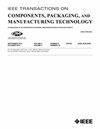Tier Transfer of Ultrathin Reconstituted- SiO₂ Chiplet Tiers
IF 2.3
3区 工程技术
Q2 ENGINEERING, ELECTRICAL & ELECTRONIC
IEEE Transactions on Components, Packaging and Manufacturing Technology
Pub Date : 2025-01-08
DOI:10.1109/TCPMT.2025.3527427
引用次数: 0
Abstract
Wafer-scale packaging techniques pave the way for achieving high-density integration in advanced chiplet-based architectures. In this letter, a wafer-scale chiplet reconstitution technology is presented, where the key idea is to encapsulate a “sea of chiplets” in low-temperature silicon dioxide (SiO2) to form a reconstituted chiplet tier. For the demonstration of an ultrathin reconstituted-SiO2 chiplet tier, 10–20-求助全文
约1分钟内获得全文
求助全文
来源期刊

IEEE Transactions on Components, Packaging and Manufacturing Technology
ENGINEERING, MANUFACTURING-ENGINEERING, ELECTRICAL & ELECTRONIC
CiteScore
4.70
自引率
13.60%
发文量
203
审稿时长
3 months
期刊介绍:
IEEE Transactions on Components, Packaging, and Manufacturing Technology publishes research and application articles on modeling, design, building blocks, technical infrastructure, and analysis underpinning electronic, photonic and MEMS packaging, in addition to new developments in passive components, electrical contacts and connectors, thermal management, and device reliability; as well as the manufacture of electronics parts and assemblies, with broad coverage of design, factory modeling, assembly methods, quality, product robustness, and design-for-environment.
 求助内容:
求助内容: 应助结果提醒方式:
应助结果提醒方式:


